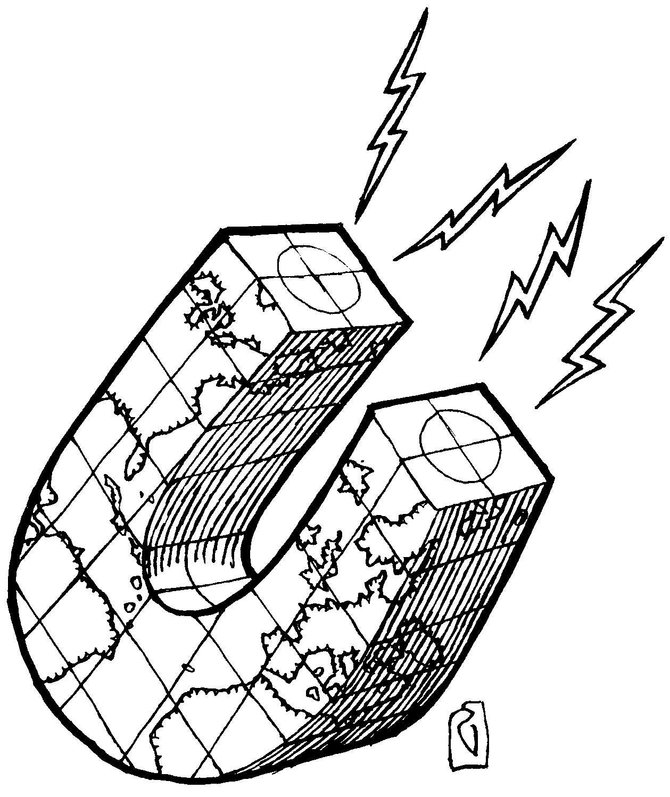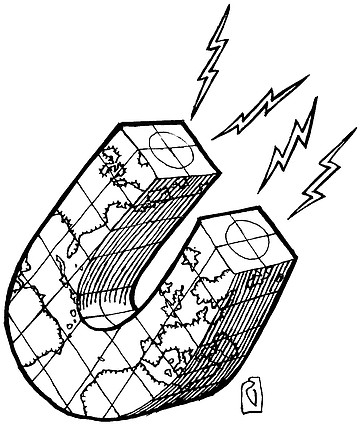 Facebook
Facebook
 X
X
 Instagram
Instagram
 TikTok
TikTok
 Youtube
Youtube

Dear Matthew: I learned that electrical power can be produced using magnets and other things. I know the Earth has a big magnetic field around it. Could this be used to generate power for the world? — Kareem, via email

I’m not sure which answer you want, the ordinary guy’s explanation or the one you’d get from Sheldon. No question that a detailed answer would reach thesis dimensions. The elves have threatened to quit if I go the Sheldon route, but they always play the quit card when the going gets tough. Not that they’ve won this battle, but I’ll go with the ordinary guy this time, for my own sake. So imagine Sheldon’s purse-lipped, squint-eyed disapproval as we wander on here.
Okay, yeah, Earth’s magnetic field does move around just enough to generate some electrical potential that could be harnessed in a metallic loop and used. (It’s magnetic field plus movement that generates current, not static fields.)
If grabbing atmospheric magnetism were easy, somebody would have done it by now. They’ve been at it for quite a while. Actually, NASA has figured out how to plug into the field, but NASA’s not interested in running your toaster-oven. Their best-advertised attempt, unfortunately, was an over-successful bust. In 1996 they sent an object into orbit, trailing a 20,000-meter-long wire-packed tether. The tether was pulled through the magnetism at pretty serious speeds to up the potential current. Not long after NASA pushed the grab-it button, the tether disintegrated. Too much current for the wires to handle. But NASA soldiered on and now uses electrical power from Earth’s magnetic field to tweak satellite orbits, power spacecraft, and other space-related applications.
The stock answer to why we Earthlings can’t benefit from this is that not enough current can be generated to make the method practical. Estimates say a tether that reaches an orbital velocity of 7 to 8 km/sec could produce several hundred volts/km. Okay, you armchair Sheldons, now’s the time to join the Gotcha Gang and email me about my idiotic oversights and downright ordinary thinking.
Hi, Matt: When my boyfriend drinks beer out of a glass, he puts a paper coaster or the like over the glass to cover the opening. I never thought of paper or glass as an insulator, but then a lot of things don’t make sense to me, especially after a couple of beers. What do ya think? — Tipsy in San Diego
Hi, Tipsy. Your boyfriend Dipsy has things a little confused. Paper (in layers) does make pretty good insulation, but he’d have to wrap an entire Reader around his glass to have it work very well. Once poured, his beer is gaining heat on all surfaces, the glass and the beer, until the funky bar air and the beer are the same temperature. Cold isn’t escaping from the top. My hunch is, Dipsy got this trick from his dad. But I’ll bet Dad did it because he thought it kept the beer from going flat. This old, old bar trick might keep your beer a little fizzier if you abandon it to shoot some pool (beer gas escapes until the beer and the air above it are equally saturated). But after the first three or four, who can tell the difference, anyway? Bars are pretty much like the real world, with lots of drunks and not many physicists.
Dear Matthew Alice: What’s the difference between silicon and silicone? Why isn’t it Silicone Valley and silicon implants? — An Aficionado, San Diego
Matt: Why do they call them boobs? — Need Facts, Escondido
The elves are snickering so hard they’re out of commission on this one. Grandma says we’re just pandering for readership. But as chairbeing of the bored of Amalgamated Alice, I get to decide, and I decide we’re down with boobs. We got ’em from the Brits, though they called them “boobies.” They got them from the Germans, via a dialect word, bubbi, which means roughly the same thing. Without the giggling.
There’s no clear path for the word, but in the U.S. boobs were all the rage in the Roaring ’20s, which suggests we got them from the British during World War I. (War may be good for absolutely nothing — say it again — except broadening our popular vocabulary with foreign and military borrows.) And the word has nothing to do with boobs, as in idiots. Pretty sure this is from Spanish. Bobos. Fools
Silicone Valley would be a very sticky place. Silicon implants? Well, I don’t even want to think about that. Silicon’s one of the world’s elements (remember those big charts from chem class? Or the Tom Lehrer song?). It’s usually a solid, found in sand, quartz, gemstones, talc, and clay, in combination with hydrogen and some kind of metal. Very cheap and very useful because it’s a semiconductor. Silicone is a synthetic polymer (plastic), usually in more or less liquid form, with a satisfying, boob-like squishiness.


Dear Matthew: I learned that electrical power can be produced using magnets and other things. I know the Earth has a big magnetic field around it. Could this be used to generate power for the world? — Kareem, via email

I’m not sure which answer you want, the ordinary guy’s explanation or the one you’d get from Sheldon. No question that a detailed answer would reach thesis dimensions. The elves have threatened to quit if I go the Sheldon route, but they always play the quit card when the going gets tough. Not that they’ve won this battle, but I’ll go with the ordinary guy this time, for my own sake. So imagine Sheldon’s purse-lipped, squint-eyed disapproval as we wander on here.
Okay, yeah, Earth’s magnetic field does move around just enough to generate some electrical potential that could be harnessed in a metallic loop and used. (It’s magnetic field plus movement that generates current, not static fields.)
If grabbing atmospheric magnetism were easy, somebody would have done it by now. They’ve been at it for quite a while. Actually, NASA has figured out how to plug into the field, but NASA’s not interested in running your toaster-oven. Their best-advertised attempt, unfortunately, was an over-successful bust. In 1996 they sent an object into orbit, trailing a 20,000-meter-long wire-packed tether. The tether was pulled through the magnetism at pretty serious speeds to up the potential current. Not long after NASA pushed the grab-it button, the tether disintegrated. Too much current for the wires to handle. But NASA soldiered on and now uses electrical power from Earth’s magnetic field to tweak satellite orbits, power spacecraft, and other space-related applications.
The stock answer to why we Earthlings can’t benefit from this is that not enough current can be generated to make the method practical. Estimates say a tether that reaches an orbital velocity of 7 to 8 km/sec could produce several hundred volts/km. Okay, you armchair Sheldons, now’s the time to join the Gotcha Gang and email me about my idiotic oversights and downright ordinary thinking.
Hi, Matt: When my boyfriend drinks beer out of a glass, he puts a paper coaster or the like over the glass to cover the opening. I never thought of paper or glass as an insulator, but then a lot of things don’t make sense to me, especially after a couple of beers. What do ya think? — Tipsy in San Diego
Hi, Tipsy. Your boyfriend Dipsy has things a little confused. Paper (in layers) does make pretty good insulation, but he’d have to wrap an entire Reader around his glass to have it work very well. Once poured, his beer is gaining heat on all surfaces, the glass and the beer, until the funky bar air and the beer are the same temperature. Cold isn’t escaping from the top. My hunch is, Dipsy got this trick from his dad. But I’ll bet Dad did it because he thought it kept the beer from going flat. This old, old bar trick might keep your beer a little fizzier if you abandon it to shoot some pool (beer gas escapes until the beer and the air above it are equally saturated). But after the first three or four, who can tell the difference, anyway? Bars are pretty much like the real world, with lots of drunks and not many physicists.
Dear Matthew Alice: What’s the difference between silicon and silicone? Why isn’t it Silicone Valley and silicon implants? — An Aficionado, San Diego
Matt: Why do they call them boobs? — Need Facts, Escondido
The elves are snickering so hard they’re out of commission on this one. Grandma says we’re just pandering for readership. But as chairbeing of the bored of Amalgamated Alice, I get to decide, and I decide we’re down with boobs. We got ’em from the Brits, though they called them “boobies.” They got them from the Germans, via a dialect word, bubbi, which means roughly the same thing. Without the giggling.
There’s no clear path for the word, but in the U.S. boobs were all the rage in the Roaring ’20s, which suggests we got them from the British during World War I. (War may be good for absolutely nothing — say it again — except broadening our popular vocabulary with foreign and military borrows.) And the word has nothing to do with boobs, as in idiots. Pretty sure this is from Spanish. Bobos. Fools
Silicone Valley would be a very sticky place. Silicon implants? Well, I don’t even want to think about that. Silicon’s one of the world’s elements (remember those big charts from chem class? Or the Tom Lehrer song?). It’s usually a solid, found in sand, quartz, gemstones, talc, and clay, in combination with hydrogen and some kind of metal. Very cheap and very useful because it’s a semiconductor. Silicone is a synthetic polymer (plastic), usually in more or less liquid form, with a satisfying, boob-like squishiness.
Comments